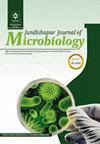Detection of KPC and VIM Genes in Carbapenem-resistant Klebsiella pneumoniae Isolates from Blood Culture in Southern Anhui, China
IF 0.5
4区 医学
Q4 MICROBIOLOGY
引用次数: 0
Abstract
Background: Klebsiella pneumoniae is one of the main pathogens of lower respiratory tract infections. Carbapenems are considered the last line of defense for the treatment of Gram-negative bacteria with multidrug resistance. In recent years, with the increase of bacteria producing carbapenemase, the resistance rate of carbapenems has increased gradually. Objectives: The main objective of this study was to detect the blaKPC and blaVIM genes in K. pneumoniae isolates from blood culture specimens. Methods: Within September 2020 to August 2022, 1033 bacterial strains were isolated from blood cultures in Yijishan Hospital of Wannan Medical College, Wuhu, Anhui province, China, including 141 strains of K. pneumoniae. All K. pneumoniae strains were processed for antimicrobial susceptibility testing (AST) using the minimum inhibitory concentration method. Meanwhile, the isolates were phenotypically identified for carbapenemase production by the colloidal gold method. Finally, the confirmed carbapenem enzyme phenotype was further verified for the production of blaKPC and blaVIM by polymerase chain reaction (PCR). Results: Regarding the rate of isolated strains in blood culture, positivity was 11.16% (1033/9255), and the proportion of K. pneumoniae was 13.65% (141/1033). Overall, according to AST results, 7.80% (11/141) of the isolates demonstrated resistance to carbapenems, such as ertapenem, imipenem, and meropenem; nevertheless, they showed sensitivity to colistin and ceftazidime/avibactam. Colloidal gold phenotypically confirmed 81.82% (9/11) of the isolates as carbapenemase producers. Subsequently, nine isolates’ strains were verified to be positive for blaKPC and blaVIM by PCR; the proportions of the blaKPC and blaVIM genes were 88.89% (8/9) and 11.11% (1/9), respectively. Conclusions: The identification of carbapenemase phenotype and genotype is helpful for the accurate understanding of drug resistance and management of the disease.皖南地区血培养的耐碳青霉烯肺炎克雷伯菌KPC和VIM基因检测
背景:肺炎克雷伯菌是下呼吸道感染的主要病原体之一。碳青霉烯类药物被认为是治疗具有多药耐药性的革兰氏阴性菌的最后一道防线。近年来,随着产生碳青霉烯酶的细菌数量的增加,碳青霉烯类抗生素的耐药率逐渐提高。目的:本研究的主要目的是检测血培养标本中肺炎克雷伯菌分离株的blaKPC和blaVIM基因。方法:在2020年9月至2022年8月期间,从安徽省芜湖市皖南医学院乙脊山医院的血液培养物中分离到1033株细菌,其中肺炎克雷伯菌141株。使用最小抑菌浓度法对所有肺炎克雷伯菌菌株进行抗菌药敏试验(AST)。同时,通过胶体金法对分离株进行碳青霉烯酶生产的表型鉴定。最后,通过聚合酶链式反应(PCR)进一步验证了已确认的碳青霉烯酶表型可产生blaKPC和blaVIM。结果:血培养分离株阳性率为11.16%(1033/9255),肺炎克雷伯菌阳性率为13.65%(141/1033)。总体而言,根据AST结果,7.80%(11/141)的分离株表现出对碳青霉烯类药物的耐药性,如厄他培南、亚胺培南和美罗培南;然而,它们对粘菌素和头孢他啶/阿维巴坦显示出敏感性。胶体金表型证实81.82%(9/11)的分离株是碳青霉烯酶的产生者。随后,9个分离株的菌株通过PCR被证实对blaKPC和blaVIM呈阳性;blaKPC和blaVIM基因的比例分别为88.89%(8/9)和11.11%(1/9)。结论:碳青霉烯酶表型和基因型的鉴定有助于准确了解该病的耐药性和治疗。
本文章由计算机程序翻译,如有差异,请以英文原文为准。
求助全文
约1分钟内获得全文
求助全文
来源期刊

Jundishapur Journal of Microbiology
MICROBIOLOGY-
CiteScore
1.30
自引率
0.00%
发文量
56
审稿时长
6-12 weeks
期刊介绍:
Jundishapur Journal of Microbiology, (JJM) is the official scientific Monthly publication of Ahvaz Jundishapur University of Medical Sciences. JJM is dedicated to the publication of manuscripts on topics concerning all aspects of microbiology. The topics include medical, veterinary and environmental microbiology, molecular investigations and infectious diseases. Aspects of immunology and epidemiology of infectious diseases are also considered.
 求助内容:
求助内容: 应助结果提醒方式:
应助结果提醒方式:


